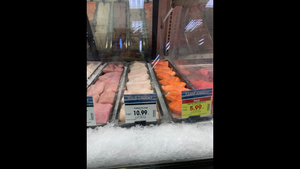Supervalu Expands Data Sync Efforts 2011-06-27
MINNEAPOLIS — As one of the industry's leading practitioners of data synchronization with its trading partners, Supervalu here now syncs more than 250,000 items with more than 900 suppliers, representing almost 70% of its non-perishable dollar volume. But the retail/wholesale giant is not resting on its laurels. Supervalu is continuing its heavy investment in the Global Data Synchronization Network
June 27, 2011
MICHAEL GARRY
MINNEAPOLIS — As one of the industry's leading practitioners of data synchronization with its trading partners, Supervalu here now syncs more than 250,000 items with more than 900 suppliers, representing almost 70% of its non-perishable dollar volume. But the retail/wholesale giant is not resting on its laurels.
Supervalu is continuing its “heavy investment” in the Global Data Synchronization Network (GDSN), the industry utility facilitating synchronization of product data between brand manufacturers and retailers, said Greg Zwanziger, Supervalu's director of ecommerce business development, during the U Connect Live conference this month.
“This is the way item information is going to be shared, and we need to continue focusing on improvements,” he said.
The past year has been especially active for adding new supplier partners to its synchronization network, said Zwanziger, adding that “this year looks even better.”
In the fourth quarter of 2011, Supervalu will have a new version of its eNew Item portal, which is tightly linked to the GDSN. The portal will be changed to “look more like the GDSN standard,” adding product attributes for each level of product shipments provided by suppliers (pallet, case, inner-pack and item), Zwanziger said.
The company also plans to synchronize direct-store delivery and bulk items (such as candy and foodservice) with suppliers, and aggressively expand synchronization efforts with fresh-food suppliers. This means that for suppliers not synchronizing data, there will be “significantly more [manual] work for your sales team,” Zwanziger said.
Supervalu is already syncing data with several DSD suppliers and expects all DSD companies in CPG categories to be publishing data through the GDSN before the end of the year. “We want data synchronization to be the process that gets [DSD] information into our systems,” he said. Supervalu has also been piloting with bakery, meat and deli suppliers and is looking to synchronize all of their item data by Dec. 1.
In produce, the company only plans for now to synchronize items that are “CPG-like,” such as bagged salads. “We'll work through the Produce Traceability Initiative to manage how we get that information shared in the near term,” he said. “In the long term, we'll find a way to make produce [synchronization] work.”
For pricing information, Supervalu, like most U.S. retailers, is not employing the GDSN. Instead, the company uses electronic data interchange (EDI), linking directly with suppliers or with brokers.
Zwanziger emphasized that Supervalu prefers that new item information come through the GDSN — even before final confirmation that Supervalu has accepted a new item — though only 20 of 900 vendors in the past six months used that process. “We get better new-item data through data synchronization,” he said.
Supervalu also expects suppliers to educate their sales and product development teams about data synchronization principles, such as the allocation of global trade item numbers (GTINs). For example, changing the net content of an item calls for a new GTIN, as does altering the packaging of an item for a seasonal reason. Failing to change the GTIN can lead to “extra cost throughout the supply chain,” including warehousing, transportation, point of sale and planograms.
Zwanziger also called on suppliers to publish accurate and complete item data. Inaccurate data, he said, creates a “significant cost to Supervalu.” Supervalu is currently measuring top vendors' data synchronization activity with a scorecard. The company plans to add data accuracy to the scorecard as well as item attribute completeness, and to evaluate more suppliers.
In another session at U Connect Live, Michael Durning, manager of data integrity for Wakefern Food Corp., said that the grocery cooperative began synchronizing variable-weight perishable-item product data with suppliers through the GDSN in May.
“We're now capable of bringing that data in,” he said. The data include gross and net weight and the number of packages within a case.
Over the next six to 12 months, the Keasbey, N.J.-based wholesale cooperative, which supports 232 ShopRite and 45 PriceRite stores, will be “working on engaging the GDSN” to support new direct-store delivery items. “We're looking to get more and better information into the DSD environment,” Durning said. “We don't want to deal with half the items in a store.”
Overall, Wakefern synchronizes 86 data attributes with more than 876 suppliers for over 20,000 warehouse items, he said.
About the Author
You May Also Like






